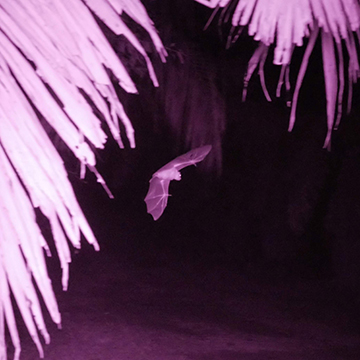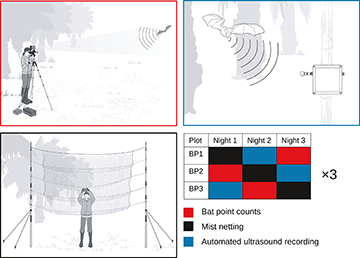
An international team of researchers developed a new method—enabled by a combination of thermal, ultrasound and near-infrared sensing—to count, detect and identify bats like this lesser short-nosed fruit bat (Cynopterus brachyotis) passing through an oil palm plantation. [Image: Ellena Yusti]
By putting together three kinds of sensors—thermal, ultrasonic and near-infrared (NIR)—an international research team has demonstrated a non-invasive method for studying bat populations and observing their behavior in the wild (Ecol. Evol., doi: 10.1002/ece3.8356). The method, named “bat point counts,” combines the three sensor types into a single instrument for field use. The researchers found that the point-counts method was as effective as traditional methods for collecting population and behavior data, but more time efficient.
In a press release accompanying the research, lead author Kevin Darras, with the University of Göttingen (Germany) and Westlake University (China), said that the team members “envisage this new method will lead to better conservation measures to protect species as well as new data to understand bat behavior.”
Hands-off observation
Current methods for studying bat populations in the wild include capturing the flying mammals at night in thin mist nets and passive acoustic monitoring with ultrasound recorders. The mist net method can miss bat species that avoid nets with echolocation, however, and physical inspection of bats caught in the nets can injure the small mammals. The ultrasound method, meanwhile, misses bat species that do not use echolocation.
The team behind the new work hopes to overcome these challenges with its bat-point-counts method. The method is analogous to the well-established bird-point-counts method, where an observer stands in a single location to listen to and view birds in flight during the day.
Bats, of course, are active mainly in the dark, and so the bat-point-counts method integrates modern sensors that allow the observer to “see” bats flying in the dark and “listen” to their echolocation calls, which are beyond the audible sound range for humans. The sensors include a thermal scope, to detect bats in flight; an ultrasound recorder, to collect bat echolocation calls; and an NIR camera paired with LEDs, to capture the morphology of the bats. Putting the three data streams together allow bat species in an area to be identified and counted.
Proof-of-principle study
Illustrations of bat sampling methods and schedule. Bat point counts were compared simultaneously against automated ultrasound recording and mist-netting in three oil palm plantation sites (Plots BP1, BP2, and BP3) for nine nights in Indonesia. [Image: K. Darras et al., Ecol. Evol., doi: 10.1002/ece3.8356; CC-BY 4.0] [Enlarge image]
After designing a workflow to most effectively process flight pattern, echolocation call, and NIR camera data from bat point counts, the researchers conducted a proof-of-principle study that compared their new method to mist netting and unmanned ultrasound methods. A field team conducted the study in three palm oil farms in Indonesia over nine nights, sampling the farms for bats on consecutive nights twice over, so that each site was sampled three times using each of the three methods.
Data from the proof-of-principle study revealed that the bat-point-counts method was comparable in effectiveness to the other two methods. But it was far more time efficient, requiring one third the sampling time as mist-netting and automated ultrasound recording.
Interestingly, the team’s field investigations using the bat-point-counts method identified very few fruit-eating bats at the farms, a finding that contradicts data from mist-netting observations. “Our new technique shows that insect-eating bats are actually much more common than previously thought in oil palm and might play a significant role in suppressing insect pests,” said Darras.
The researchers concluded that each method provides information the others do not. Mist-netting has higher species-level identification accuracy; automated ultrasound recordings are more efficient and practical for sampling echolocating bats; and bat point counts are safer for the bats and could serve, with bird-point-counts data, to sample all flying vertebrates in a given area.
Next steps and future applications
The researchers hope to test the bat-point-counts rig in additional bat habitats to more accurately assess its performance. They also believe that technological advances in the near future will lower the cost and increase the practicality and efficacy of the rig.
In the paper, the team concludes that “bat point counts, as a direct observation method that makes bats audible and visible, shine a new light on flying bat communities and their behavior, and will potentially lead to new insights.”

